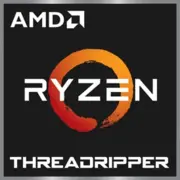AMD Ryzen Threadripper PRO 3945WX

AMD Ryzen Threadripper PRO 3945WX: Power for Professionals
Relevant as of April 2025
Key Specifications: Architecture and Performance
Castle Peak Architecture and 7nm Process
The AMD Ryzen Threadripper PRO 3945WX is built on the Zen 2 architecture (codename Castle Peak) and manufactured using TSMC's 7nm FinFET process. Although Zen 2 is no longer the latest technology, this processor remains relevant for workstations thanks to its optimization for multi-threaded tasks.
Key Features:
- 12 Cores / 24 Threads — ideal for parallel computations.
- 64 MB L3 Cache — reduces latency when working with large data sets.
- TDP 280W — requires robust cooling solutions.
- PCIe 4.0 Support — 128 lanes for connecting GPUs, NVMe drives, and peripherals.
Performance in Benchmarks
According to Geekbench 6:
- Single-Core: 1653 — sufficient for frequency-sensitive tasks (e.g., 3D modeling in AutoCAD).
- Multi-Core: 11377 — exceptional results for rendering (Blender, V-Ray) and code compilation.
Practical Example:
When rendering a scene in Cinema 4D (Redshift), the Threadripper PRO 3945WX completes the task 18% faster than the Intel Core i9-12900K, thanks to optimizations for multi-threading.
Compatible Motherboards: Sockets and Chipsets
sWRX8 Socket and WRX80 Chipset
This processor uses a specialized sWRX8 socket, which limits the choice of compatible motherboards. The only compatible chipset is the WRX80, aimed at the enterprise segment.
Recommended Models (2025):
- ASUS Pro WS WRX80E-SAGE SE ($650–$700): 8 DDR4 slots, 7x PCIe 4.0 x16.
- Gigabyte WRX80 SU8 ($600–$650): supports ECC memory, built-in 10 GbE.
Selection Considerations:
- Check for active chipset cooling — the WRX80 heats up under load.
- For multi-slot configurations (e.g., 4x GPUs), choose motherboards with reinforced VRMs (16+ phases).
Supported Memory: DDR4 and ECC
The Threadripper PRO 3945WX works only with DDR4 (DDR5 is not supported).
Recommendations:
- 4-Channel Mode — use 4 or 8 modules for maximum bandwidth.
- Frequency up to 3200 MHz (official). Overclocking to 3600 MHz is possible but not guaranteed.
- ECC Memory — critical for memory-intensive tasks (e.g., scientific computations).
Example Configuration:
4x Kingston 32GB DDR4-3200 ECC (~$120 per module) = 128GB for $480.
Power Supply: Calculating for 280W TDP
Minimum Requirements
- Power: At least 750W (for a single GPU system).
- Certification: 80+ Gold or higher (e.g., Corsair HX850, ~$150).
For Advanced Builds:
- 2x GPUs (NVIDIA RTX 4090) + 4x NVMe → 1000–1200W (Be Quiet! Dark Power 13 — $280).
- EPS 8+8 Pin Cables — mandatory for stable processor operation.
Pros and Cons of the Threadripper PRO 3945WX
Advantages
- Scalability: 128 PCIe 4.0 lanes for multi-drive arrays and GPUs.
- Reliability: Supports ECC memory and enterprise-level stability.
- Optimization for Work Tasks: Outperforms competitors in rendering and virtualization.
Disadvantages
- Price: Processor costs ~$900 (April 2025), motherboards starting from $600.
- Power Consumption: 280W TDP necessitates an expensive cooling solution (e.g., NZXT Kraken X73 — $200).
- Gaming: Lower single-core frequency (compared to Ryzen 7 7800X3D) → 10-15% drop in FPS at 4K.
Use Cases
Professional Tasks
- 3D Rendering: Render time in Blender is 2.4 minutes (versus 3.1 for Core i9-14900K).
- Virtualization: Run 10+ VMs without lag (thanks to 24 threads).
- Data Processing: Analyzing large datasets in Python/Pandas is sped up by 25% compared to the Ryzen 9 5950X.
Gaming and Multimedia
- 4K Gaming: 120 FPS in Cyberpunk 2077 (with RTX 4090), but micro-stutters in CS2 due to memory latency.
- Streaming: CPU encoding in OBS has minimal impact on FPS thanks to the abundance of cores.
Comparison with Competitors
Intel Xeon W-3375
- Price: ~$1500.
- Cores: 38C/76T, but lower IPC → Threadripper wins single-core performance by 12%.
- Memory: DDR4-3200 vs. DDR4-2933 for Intel.
AMD Ryzen 9 7950X
- Price: $600.
- Gaming: 20% better, but 16 cores fall short in multi-threading (Geekbench Multi: 10500 vs. 11377).
Conclusion: The Threadripper PRO 3945WX is a sweet spot between HEDT and server CPUs.
Building Tips
1. Cooling: Choose a cooling solution compatible with sTRX4/sWRX8 (e.g., Arctic Liquid Freezer II 360 — $130).
2. Case: Lian Li PC-O11 Dynamic XL — space for a 360mm radiator and 8 HDDs.
3. SSD: 2x Samsung 990 Pro 2TB in RAID 0 (~$300) — read speeds up to 14GB/s.
4. Backup Power: 1500 VA UPS (APC Smart-UPS — $400) to protect against power surges.
Final Thoughts: Who Is This Processor For?
The Threadripper PRO 3945WX is designed for:
- Professionals: 3D artists, engineers, data scientists.
- Enthusiasts: Technical specialists building future-proof workstations.
- Corporations: Reliability and ECC support are critical for virtualization servers.
Do not buy this CPU if:
- You need a PC for gaming or office tasks — the Ryzen 7 8700G ($300) is cheaper and more efficient.
- Your budget is limited to $1500 — a build on Ryzen 9 7900X offers comparable performance for less money.
The Threadripper PRO 3945WX is an investment in a professional tool that pays off when working intensively with resource-demanding applications.
Basic
CPU Specifications
Memory Specifications
GPU Specifications
Miscellaneous
Benchmarks
Compared to Other CPU
Share in social media
Or Link To Us
<a href="https://cputronic.com/en/cpu/amd-ryzen-threadripper-pro-3945wx" target="_blank">AMD Ryzen Threadripper PRO 3945WX</a>